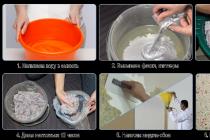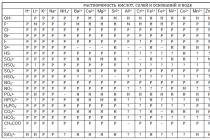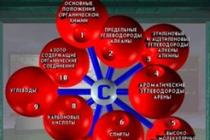There are many organic compounds, but among them there are compounds with general and similar properties. Therefore, they are all classified according to common characteristics, combined into separate classes and groups. The classification is based on hydrocarbons – compounds that consist only of carbon and hydrogen atoms. The rest of the organic matter belongs to "Other classes of organic compounds."
Hydrocarbons are divided into two broad classes: acyclic and cyclic compounds.
Acyclic compounds (fatty or aliphatic) – compounds, the molecules of which contain an open (not closed in a ring) unbranched or branched carbon chain with simple or multiple bonds. Acyclic compounds are classified into two main groups:
saturated (saturated) hydrocarbons (alkanes), in which all carbon atoms are linked to each other only by simple bonds;
unsaturated (unsaturated) hydrocarbons, in which between the carbon atoms, in addition to single simple bonds, there are also double and triple bonds.
Unsaturated (unsaturated) hydrocarbons are divided into three groups: alkenes, alkynes and alkadienes.
Alkenes(olefins, ethylene hydrocarbons) – acyclic unsaturated hydrocarbons, which contain one double bond between carbon atoms, form a homologous series with the general formula C n H 2n. The names of alkenes are derived from the names of the corresponding alkanes, with the suffix "-an" replaced by the suffix "-en". For example, propene, butene, isobutylene, or methylpropene.
Alkyne(acetylene hydrocarbons) – hydrocarbons that contain a triple bond between carbon atoms form a homologous series with the general formula C n H 2n-2. The names of alkenes are derived from the names of the corresponding alkanes with the replacement of the suffix "-an" by the suffix "-in". For example, ethin (acithelen), butin, peptin.
Alkadienes – organic compounds that contain two carbon-carbon double bonds. Depending on how the double bonds are located relative to each other, dienes are divided into three groups: conjugated dienes, alleles, and dienes with isolated double bonds. Typically, dienes include acyclic and cyclic 1,3-dienes, forming with the general formulas C n H 2n-2 and C n H 2n-4. Acyclic dienes are structural isomers of alkynes.
Cyclic compounds, in turn, are divided into two large groups:
- carbocyclic compounds – compounds whose cycles consist only of carbon atoms; Carbocyclic compounds are classified into alicyclic – saturated (cycloparaffins) and aromatic;
- heterocyclic compounds – compounds whose cycles consist not only of carbon atoms, but atoms of other elements: nitrogen, oxygen, sulfur, etc.
In molecules of both acyclic and cyclic compounds hydrogen atoms can be replaced by other atoms or groups of atoms, thus, by introducing functional groups, derivatives of hydrocarbons can be obtained. This property further expands the possibilities of obtaining various organic compounds and explains their diversity.
The presence of certain groups in the molecules of organic compounds determines the generality of their properties. This is the basis for the classification of hydrocarbon derivatives.
 Other classes of organic compounds include the following:
Other classes of organic compounds include the following:
Alcohols obtained by replacing one or more hydrogen atoms with hydroxyl groups – OH. This compound with the general formula R – (OH) x, where x – the number of hydroxyl groups.
Aldehydes contain an aldehyde group (C = O), which is always at the end of the hydrocarbon chain.
Carboxylic acids contain one or more carboxyl groups – COOH.
Esters – derivatives of oxygen-containing acids, which are formally products of substitution of hydrogen atoms of hydroxides – OH acid function on hydrocarbon residue; are also considered as acyl derivatives of alcohols.
Fats (triglycerides) – natural organic compounds, full esters of glycerol and mono-fatty acids; belong to the class of lipids. Natural fats contain three unbranched acid radicals and usually an even number of carbon atoms.
Carbohydrates – organic substances that contain an unbranched chain of several carbon atoms, a carboxyl group and several hydroxyl groups.
Amines contain an amino group – NH 2
Amino acids– organic compounds, the molecule of which simultaneously contains carboxyl and amine groups.
Squirrels – high molecular weight organic substances, which are composed of alpha - amino acids linked in a chain by a peptide bond.
Nucleic acids – high molecular weight organic compounds, biopolymers formed by nucleotide residues.
Still have questions? Want to know more about the classification of organic compounds?
To get help from a tutor - register.
The first lesson is free!
site, with full or partial copying of the material, a link to the source is required.
In all the compounds that were considered in the previous chapters, the carbon atoms were linked to each other in a chain, these compounds are called acyclic. However, in many compounds, the carbon atoms are connected in such a way that rings are formed; such connections are called cyclic.
This chapter will discuss cycloalkanes and cycloalkenes. Much of the chemistry of these cyclic aliphatic hydrocarbons is already known to us, since it is largely identical to the chemistry of acyclic alkanes and alkenes. However, there are some differences in properties associated with the presence of a cyclic structure, and it is these peculiar properties that will be mainly considered.
9.2. Nomenclature
The names of cyclic aliphatic hydrocarbons are formed by adding the prefix cyclo- to the name of the corresponding acyclic hydrocarbon with the same number of carbon atoms, for example:
The substituents present in the ring are called, as usual, and their position in the ring is designated with numbers so that the minimum combination of numbers is obtained. In simple cycloalkenes and cycloalkynes, carbon atoms connected by double and triple bonds are designated by numbers 1 and 2, for example:

For convenience, aliphatic rings are often depicted in the form of simple geometric shapes: cyclopropane - a triangle, cyclobutane - a square, cyclopentane - a pentagon, cyclohexane - a hexagon, etc. This implies that each corner of the figure has two hydrogen atoms, if only the presence of other groups is not indicated.

9.3. Physical properties
The physical properties of cyclic aliphatic hydrocarbons (Table 9.1) are similar to those of the corresponding acyclic hydrocarbons (Table 4.3, page 108, and Table 5.2, page 151), although the boiling points and densities of cyclic compounds are slightly higher.
Table 9.1 (see scan) Cyclic aliphatic hydrocarbons
Since cyclic hydrocarbons are non-polar or low-polarity compounds, they are soluble in non-polar or low-polar solvents such as hydrocarbon tetrachloride, naphtha, or ether, and insoluble in a highly polar solvent such as water.
9.4. Industrial sources
As already mentioned in Sec. 4.15, the oil of some fields (in particular, Californian) contains a large amount of cycloalkanes, called nafgpenam in the industry. These include cyclohexane, methylcyclohexane, methylcyclopentane and 1,2-dimethschlopentane.
These cycloalkanes give aromatic hydrocarbons upon catalytic conversions. Such a process serves as one of the main sources for the production of these important compounds (Section 12.4), for example:

If the abstraction of a hydrogen atom from cyclic aliphatic compounds can lead to aromatic compounds, then using the reverse process, hydrogen addition, cyclic aliphatic compounds, especially cyclohexane derivatives, are obtained from aromatic compounds. An important example of such a reaction is the production of pure diclohexane by hydrogenation of benzene

As expected, hydrogenation of substituted benzenes gives substituted cyclohexane derivatives, for example:

A wide variety of cyclic compounds containing a six-membered ring can be prepared from cyclohexanol.
9.5. Synthesis methods
The process of obtaining cyclic aliphatic hydrocarbons from other aliphatic compounds generally consists of two stages: a) conversion of any compound containing an open chain into a cyclic compound by a reaction called cyclization (or ring closure); b) converting the resulting cyclic compound into the desired product, for example a cyclic alcohol to a cycloalkane or a cycloalkene to a cycloalkane.
Most cyclization methods do not directly yield hydrocarbons, but lead to the formation of other types of compounds, which will be discussed in Sec. 35.14. The reactions used for cyclization are based on standard preparative methods specially adapted to the ring closure problem. The principle of this approach can be illustrated by the example of obtaining cyclopropane, one of the few cyclic aliphatic hydrocarbons that can be obtained by direct cyclization in good yield.
The action of a metal (usually sodium) on an alkyl halide according to the Würz reaction (Section 4.19) leads to the formation of a bond between the carbon atoms of two alkyl groups

In the same way, the action of a metal on a dihalogen derivative leads to the formation of a bond between two carbon atoms that are part of the same molecule

In the latter case, better results are obtained with zinc than with sodium. Although this reaction leads to good yields only in the case of cyclopropanes and therefore is not used for the preparation of most cycloalkanes, this synthesis illustrates very well the application of a standard synthetic technique to the special problem of obtaining a cyclic compound.
Cyclic aliphatic hydrocarbons are obtained from other types of cyclic compounds (for example, halogen derivatives or alcohols) in exactly the same way as used for the synthesis of acyclic hydrocarbons from other acyclic derivatives.
(see scan)
The direct synthesis of the cyclopropane ring using methylenes will be discussed in Sec. 9.19 and 9.20 after familiarization with the stereochemistry of cyclic compounds.
9.6. Reactions
With the exception of a small number of very important and interesting reactions, cyclic aliphatic hydrocarbons undergo the same transformations as their acyclic counterparts.

Cycloalkenes are mainly characterized by addition reactions, both electrophilic and free radical (cf. Section 6.2); like other alkenes, they can also undergo cleavage and allyl substitution reactions, for example:

Two cycloalkanes with the smallest rings - cyclopropane and cyclobutane - have a number of chemical properties that sharply distinguish them from other members of the series. While these exceptional properties may seem surprising at first glance, they are quite simple to explain.

Send your good work in the knowledge base is simple. Use the form below
Students, graduate students, young scientists who use the knowledge base in their studies and work will be very grateful to you.
Posted on http://www.allbest.ru/
Lecture 5.Cyclic connections
arene cycloalkane isomerism hydrogenation
Carbon has a unique ability - to form a variety of stable cyclic structures (the word "cycle" goes back to the Greek - a circle). Other chemical elements can also form cycles, for example, rhombic and monoclinic sulfur contains crown-shaped S 8 rings, and rhombohedral sulfur contains chair-like S 6 rings.
The structure of the S 8 molecule according to CSD1 data
However, carbon alone gives a huge, endless variety of cyclic structures.
Cyclic compounds can be homocyclic and heterocyclic.
Homocyclic (Greek - the same) compounds contain atoms of only one chemical element in the cycle. If these are carbon atoms, then such compounds are called carbocyclic (Latin carboneum - carbon).
Examples of carbocyclic compounds are shown below.
Cyclopropane (inhalation anesthetic)
If atoms of different elements are present in the cycle, then such compounds are called heterocyclic (Greek - different). For example:
hexogen nicotine
Heterocyclic compounds will be discussed at the very end of the course.
Cyclic hydrocarbons
Usually, cyclic hydrocarbons are divided into alicyclic hydrocarbons (cycloalkanes, cycloalkenes, etc.) and aromatic hydrocarbons.
In addition, cyclic structures can be classified depending on the features of the structure on monocyclic , bridge (condensed cycles: bicycles, tricycles, etc.) and spiro cycles ... In bridging structures, at least two atoms belong to two cycles, while in spiro compounds, only one atom is common for two cycles.
cyclohexane
decalin (bridged bicyclic hydrocarbon)
spiropentane
Cycloalkanes
Cycloalkanes (cycloparafines, naphthenes, cyclanes, polymethylenes) saturated hydrocarbons with a closed (cyclic) carbon chain. General formula of cycloalkanes WITH nH 2n.
1. Classification and structure of cycloalkanes
Cycloalkanes are classified according to the ring size, which is determined by the number of carbon atoms in the ring.
Table 1. Cycloalkanes (CH 2) n
|
substance |
classification |
||
|
cyclopropane |
small cycle |
||
|
cyclobutane |
small cycle |
||
|
cyclopentane |
normal cycle |
||
|
cyclohexane |
normal cycle |
||
|
cycloheptane |
normal cycle |
||
|
cyclooctane |
middle cycle |
||
|
cyclononan |
middle cycle |
||
|
cyclodecane |
middle cycle |
||
|
cycloundecane |
middle cycle |
||
|
cyclododecane |
macrocycle |
It is easy to see that there are 2 small cycles, 3 usual, 4 medium ones.
Carbon atoms in cycloalkanes, as in alkanes, are in the sp 3 - hybridized state, therefore, bond angles should be equal to 109 o 28 ". However, this is not observed in small cycles of -cyclopropane and cyclobutane, which determines their peculiar chemical properties.
Cyclopropane.
The cyclopropane molecule is an equilateral triangle with C-C-C bond angles equal to 60o.
Cyclopropane molecule structure according to CSD2 data
In the case of cyclopropane, a significant deviation of the C-C-C bond angle from the optimal value is observed (here 60 o instead of 109 o 28 "), as a result of which a significant increase in energy, a decrease in stability and an increase in reactivity are observed.
· It is pertinent to make such a comparison - imagine that you have compressed the spring - in this case, the energy of the spring will increase, since the geometric parameters of the spring deviate from the optimal values.
The increase in energy caused by the deviation of the bond angle from the optimal value is called the angular stress, or Bayer stress.
An unusual type of s-bond is realized between carbon atoms in cyclopropane - a "banana" or - t-bond (tau bond): the maximum overlapping of orbitals is not located on a straight line connecting the nuclei of two atoms, therefore the orbitals do not overlap completely, the C-C covalent bond is fragile and easy to tear.
All hydrogen atoms in cyclopropane are in the occluded position:
1 kcal / mol
Therefore, in addition to the angular stress, in this case there is torsion voltage (tension of opposing bonds or Pitzer tension) - an increase in energy due to the electronic repulsion of bonds that are in an obstructed position. Each bond in the occluded position increases the energy of the system by 1 kcal / mol (highlighted in red).
The same types of stresses are present in another small cycle, cyclobutane (especially in its flat conformation):
Cyclopropane molecule structure according to CSD3 data
The angular stress in the cyclobutane molecule is less than in the cyclopropane molecule, since the C-C-C bond angle (90 o) does not deviate so much from the optimal value as in the case of cyclopropane (60 o).
In cyclopentane, angular stress is practically absent, but torsional stress appears. Note that almost all hydrogen atoms are in an eclipsed position:
envelope conformation of cyclopentane
There are no stresses at all in the “chair” conformation of cyclohexane; therefore, the six-membered rings are especially stable and distributed innature.
In the “chair” conformation of cyclohexane, axial and equatorial bonds are distinguished. The axial bonds are parallel to the third-order symmetry axis passing through the center of the molecule, and the equatorial ones are almost perpendicular:
Axis of symmetry of the third order
Cyclohexane also has other important conformations - a twist form (which is a conformer), a half-chair or half-twist (the most energetically unfavorable form for cyclohexane), and a bath (a transitional form between twist forms):
In nature, mainly five and six-membered cycles are widespread.
Howdue to pursuit To education five and six-membered cycles?
It is obvious that the presence in nature mainly of five and six-membered cycles is explained by their increased energy stability.
This can be demonstrated using the heats of combustion of cycloalkanes reduced to one methylene group (i.e., the heat of combustion of a cycloalkane is divided by the number of carbon atoms in the cycle).
Rice. 1. Dependence of the heat of combustion of cycloalkanes reduced to one methylene group on the amount by a carbon atom
As can be seen from Table 2 and from the graph, the heats of combustion of cycloalkanes, reduced to one methylene group, reach a minimum in the case of cyclohexane.
The six-membered cycle is stress-free and the most stable. Small cycles (cyclopropane and cyclobutane) contain angular(Bayer) and torsion voltage, in the middle cycles (cyclooctane) there is a voltage Prelog(transannular tension), which makes them less preferable from an energetic point of view.
Transannular stress in cyclooctane
2. Isomerism of cycloalkanes
2.1 Structural isomerism
2.1.1 Carbon skeleton isomerism
a) rings (ring size)
b) deputies
2.1.2 Isomerismpositions of substituents in the ring
2.1.3 Mperclass isomerism with alkenes
2.2 Spatial isomerism
Cis-trans isomerism in cycloalkanes is due to the different mutual arrangement of substituents in space relative to the plane of the ring. In the cis isomers, the substituents are on one side of the plane of the ring, in the trans isomers, on opposite sides:
Cis-trans isomerism is observed in the case of unsubstituted bicycloalkane -decalin.
· Decalin, C 10 H 18 is a colorless, strong odor liquid. Solvent of fats, paints and varnishes, rubbers, synthetic resins; resin substitute.
Decalin consists of two condensed cyclohexane rings that can be joined in different ways to form cis and trans isomers:
trans-decalin cis-decalin
trans-decalin cis-decalin
The decalin moiety is included in steroids. If trans-decalin is present in the steroid structure, then it is a β-steroid, on the contrary, if the steroid contains cis-decalin, then it is a β-steroid.
Steroids are derivatives of the sterane hydrocarbon.
Steran (cyclopentaneperhydrofenanthrene, gonane) is a saturated tetracyclic hydrocarbon:
The sterane nucleus underlies many biologically and physiologically active substances, for example:
Cholesterol
Bile acids
Steroid hormones
Cardiotonic glycosides
Optical isomerism.
If it is impossible to draw the plane of symmetry through the cycloalkane molecule, a condition arises for the implementation of enantiomerism. For example, trans-1,2-dimethylcyclopropane can exist as two optical isomers, related to each other as an object and its mirror image.
NB! Try combining these two isomers.
Conformational diastereomerism
Monosubstituted cyclohexane can exist in the form of two conformational diastereomers: in the form of axial and equatorial isomers, between which equilibrium is established, which is shifted towards the formation of equatorial methylcyclohexane:
axial methylcyclohexane equatorial methylcyclohexane
Thus, the substituents, as a rule, “prefer” to be in the equatorial position.
NB! When the equatorial isomer turns into an axial one, an inversion (“eversion”) of the cycle occurs.
Why equatorial methylcyclohexane energetically more profitable, howaxial?
A steric interaction occurs between the substituent in the axial position and axial hydrogen atoms at every third carbon atom - 1,3-diaxial interaction.
As a rule, there is a mutual repulsion between the substituent and these hydrogen atoms.
axial isomer equatorial isomer
In the case of the axial arrangement of the substituent, the atoms of the substituent (in this case, the methyl group) and the axial hydrogen atoms of every third carbon atom are close together. As a result, van der Waals repulsion occurs, the energy of the molecule increases (in this case, by 1.7 kcal / mol - you can calculate the ratio of isomers in the mixture using the well-known formula? G = - RTlnK).
In the case of the equatorial arrangement of the methyl group, it is distant from the axial hydrogen atoms, therefore, the energy of the molecule is less, and therefore it is more stable.
The barrier to mutual conversion of two conformational diastereomers is very small in order to be able to isolate both diastereomers under normal conditions. However, crystallization, as a rule, forms a more stable conformational diastereomer - equatorially substituted cyclohexane.
3 ... Physical and biological properties
The melting and boiling points of cycloalkanes naturally increase with an increase in their molecular weight:
Rice. 2. dependence of the boiling point of cicolalkanes on the number of atoms in the cycle.
Under normal conditions, cyclopropane and cyclobutane are gases, cycloalkanes C5 - C16 are liquids, starting from C17 are solids.
Cycloalkanes are hydrophobic substances; therefore, they are readily soluble in hydrophobic solvents and poorly soluble in polar hydrophilic solvents (for example, in water).
Cycloalkanes have narcotic properties; therefore, cyclopropane is used in medicine as a means for inhalation anesthesia.
4 ... Chemical properties
The chemical properties of cycloalkanes depend on the size of the cycle. Small cycles (three- and four-membered cycles) exhibit very peculiar properties.
The properties of ordinary, medium and macrocycles practically do not differ from the properties of the corresponding alkanes.
Why do small cycles stand out so sharply among cycloalkanes?
The energy of cyclopropane and cyclobutane is significantly higher than the energy of all other cycloalkanes due to the presence of significant angular and torsional stress. Consequently, much less energy is required to open these cycles than in all other cases. Therefore, cyclopropane, cyclobutane and their derivatives easily enter into addition reactions, exhibiting the nature of unsaturated compounds.
4.1 Hydrogenatedue - addition of hydrogen
The ease of addition reactions increases with an increase in the intensity of the cycle in the series:
cyclopropane> cyclobutane >> cyclopentane.
Cyclopropane and cyclobutane are easily converted to alkanes by passing their mixture with hydrogen over powdered nickel (Willstatter). Hydrogenation
cyclopropane starts at 80 o C, for the hydrogenation of cyclobutane requires a higher temperature, 180 o C. For the hydrogenation of cyclopentane, cyclohexane, etc. strict conditions are necessary. For example, cyclopentane is hydrogenated only at 300-310 o C over platinum as a catalyst (Zelinsky).
However, is the double bond entirely? the same breaks apart easier than the bond in cyclopropane - ethylene is hydrogenated already at a temperature of 40 o C over nickel.
4 .2 Connection of halogens and hydrogen halides
Cyclopropane and its derivatives readily add halogens and hydrogen halides. Hydrogen iodide converts cyclopropane to 1-iodopropane, and bromine in sunlight into 1,3-dibromopropane:
4 .3 Radical substitution reactions - SR
Like alkanes, cycloalkanes easily enter into radical substitution reactions.
cyclohexane chlorocyclohexane
4.4 Dehydrogenation - hydrogen abstraction
Cycloalkanes, like alkanes, also enter into dehydrogenation reactions, while unsaturated compounds are formed:
Small cycles on heating and under the action of catalysts open the cycle and turn into alkenes (Ipatiev):
4 .5 Oxidation
Cycloalkanes, like any other hydrocarbon, burn to form carbon dioxide and water. Cycloalkanes do not react with potassium permanganate solution.
5 ... Getting cycloalkanes
5 .1 Natural sources
Cycloalkanes were first discovered in oil (therefore they are called naphthenes) by the Russian chemist V.V. Markovnikov.
Some oils contain large amounts of cycloalkanes, mainly derivatives of cyclopentane and cyclohexane.
5 .2 IntUtrimolecular Wurtz reaction
The action of active metals (Na, Zn) on dihalogenated alkanes leads to the formation of various cycloalkanes:
5 .3 Dhydrocyclization of alkanes
pentane cyclopentane
5 .4 Hydrogenation of arenas
Cyclohexane and its alkyl derivatives are obtained by hydrogenation of benzene and its homologues, which are refined products (Sabatier-Sanderan):
toluene methylcyclohexane
Using platinum as a catalyst, benzene can be reduced to cyclohexane even at room temperature.
Aroma
The term aroma has nothing to do with smell (aroma).
There are aromatic substances that are odorless and odorless, and there are a large number of non-aromatic compounds that are odorless. Why then did benzene come to be called an aromatic compound?
One of the strong smelling substances is vanillin. The structure of vanillin is related to the structure of benzoic acid, and e? the structure is related to the structure of benzene. This is how benzene and its derivatives got the epithet “aromatic”. In addition, many aromatic compounds really smell - benzene, toluene, xylenes, naphthalene.
The history of aromatic compounds began in 1825, when M. Faraday reported that during the thermal decomposition of blubber (whale oil) a substance was formed, which he called “hydrogen bicarburet”. In 1833 E. Mitscherlich obtained the same substance by decomposition of benzoic acid and gave it the name "gasoline". Now this substance is called benzene, and the word “benzene” is used in English literature.
The formula of benzene C 6 H 6 indicates a high degree of unsaturation of benzene (a saturated hydrocarbon should have the formula C 6 H 14). Therefore, it can be expected that benzene should easily add bromine, as alkenes do.
However, benzene does not add bromine under normal conditions:
This amazing inertness of the unsaturated compound has long been a criterion for placing unsaturated compounds in the aromatic series.
Disputes about the structure of benzene were conducted in the 19th century for about 30 years; many different structures have been proposed. The structure of 1,3,5-cyclohexatriene proposed by the German chemist F.A. Kekule and which is still used today. However, a serious problem immediately arose: ortho-disubstituted benzenes should have two isomers:
However, such isomers have never been discovered! Therefore, they began to believe that double bonds in benzene move freely in the cycle and these two isomers simply pass into each other:
However, as it turned out later, benzene is not 1,3,5-cyclohexatriene, double bonds do not move, benzene does not exist in the form of two isomers, and it turned out that there are no double bonds in benzene at all.
It is currently believed (Coulson, Ingold, Pauling, Wyland) that double bonds are delocalized, which can be depicted as two resonance structures
Recall that a double-edged arrow does not mean that these two structures merge into each other. It means that these two extreme structures describe the structure of benzene when superimposed on each other. This phenomenon is called resonance (resonance in chemistry should not be confused with resonance in physics).
Between the carbon atoms there is not a double and not a single bond, but an intermediate bond, and therefore all C-C bonds in benzene are equivalent.
Indeed, the C-C bond length in benzene (0.139 nm) lies between the single bond length (0.154 nm) and the double bond length (0.134 nm).
The p-electrons of all carbon atoms interact with each other by lateral overlap of adjacent p-orbitals located perpendicular to the plane passing through the benzene ring. As a result of overlapping, they delocalize with the formation of a single cyclic p-electron cloud located above and below the plane of the ring in the form of two tori (a torus is a donut-shaped object).
overlapping p-electrons p-electron cloud
Therefore, to show this delocalization, benzene and its analogs are often depicted with a circle inside the cycle:
We will depict it as 1,3,5-cyclohexatriene with double bonds, meaning that these bonds are delocalized and there are no double bonds in benzene.
Delocalization of electrons leads to a decrease in energy and an increase in the stability of the system. How to show it?
Hydrogenation of 1 mol of cyclohexene over platinum releases 28.8 kcal of heat:
There are three “double bonds” in benzene, which means that during the hydrogenation of benzene, three times the amount of heat should be released - 28.8 3 = 86.4 kcal.
However, hydrogenation of 1 mol of benzene releases only 49.8 kcal of heat:
This means that benzene is more stable than we expected at 36.6 kcal / mol (86.4 - 49.8). This quantity is called the empirical resonance energy.
But in fact, as a result of electron delocalization, benzene is more stable not by 36.6 kcal / mol, but by 64 kcal / mol, since still? 27 kcal / mol is needed to align all bonds in the cyclohexatriene-1,3,5 molecule
This energy - 64 kcal / mol - is called vertical resonance energy or delocalization energy. This number means that benzene is 64 kcal / mol more stable than we might expect. The delocalization energy of benzene is very significant (for example, compared to the delocalization energy for 1,3-butadiene (3 kcal / mol)). Therefore, benzene has high thermodynamic stability due to electron delocalization.
Aromatic compounds include compounds with such an unusually high thermodynamic stability resulting from the delocalization of p-electrons.
So, initially, unsaturated substances with unusual chemical stability were attributed to aromatic compounds, at present they include unsaturated substances with unusually high thermodynamic stability.
What criteria can be used to classify a compound as aromatic?
Aromaticity criteria
1. Atoms in the sp2-hybridized state form a planar cyclic system.
2. Conjugation covers the entire cycle, there are no breaks in the conjugation in the cycle.
3. Hückel's rule. The number of conjugated p-electrons (N) in a closed system of conjugated bonds is 4n + 2.
N is the number of p-electrons conjugated in the cycle.
n is an integer 0,1,2,3….?
Consider the prototype of all aromatic compounds - benzene. It is a cyclic, planar molecule with conjugated double bonds. The number of conjugated p-electrons (N) is six: 6 = 4n + 2, therefore, n = 1
Is cyclobutadiene an aromatic compound?
The cyclobutadiene molecule is flat, has two conjugated double bonds, the number of conjugated p-electrons (N) is four. 4 = 4n + 2, therefore n = 0.5.
It follows that cyclobutadiene is not an aromatic compound.
Hückel's rule also applies to condensed-cycle hydrocarbons. Consider mothballs.
The naphthalene molecule is flat, the number of conjugated p-electrons is 10.10 = 4n + 2, therefore, n = 2.
It follows that naphthalene is an aromatic compound.
Aromaticity of ions.
When the hydride ion (H-) is formally separated from cyclopropene, a cyclopropenonium cation is formed with aromatic properties (n = 0, N = 2):
When a proton is removed from 1,3-cyclopentadiene, an aromatic cyclopentadienyl anion is formed (n = 1, N = 6):
The cyclopentadienyl anion can form a complex with an iron ion, which is a sandwich compound:
· Ferrocene is an orange crystalline powder. It is used as a heat stabilizer for polyethylene and diene rubbers; it is used in the synthesis of some medical preparations and in electrochemistry. The discovery of ferrocene in 1951 stimulated the development of the chemistry of p-complex compounds
Lecture 5.1 Arenas(aromatic hydrocarbons)
Arenas are cyclic compounds with an aromatic p-system. They have significant thermodynamic stability and relatively low reactivity.
1. The structure of arenas
The simplest representative of arenas is benzene:
The benzene molecule is flat, the bond angles are 120 o. Between the carbon atoms there is not a double and not a single bond, but a one and a half bond, and therefore all C-C bonds in benzene are equivalent. Indeed, the length of the C-C bond in benzene (0.139 nm) is in the range between the values for the single bond (0.154 nm) and the double bond (0.134 nm).
Hydrogen atoms can be replaced by various hydrocarbon radicals to form benzene homologues:
toluene o-xylene m-xylene p-xylene
ethylbenzene isopropylbenzene (cumene)
Multi-core arenas- naphthalene, anthracene, phenanthrene and many others contain several condensed benzene rings:
naphthalene anthracene phenanthrene
2. Nomenclature
For arenes, trivial names are widely used (toluene, xylene, cumene, naphthalene, anthracene, phenenthrene, pyrene, perylene, etc.). Systematic names are built from the name of the radical (prefix) and the stem corresponding to the parent hydrocarbon (root):
methylbenzene 1,2-dimethylbenzene 1-methylnaphthalene 9-methylanthracene
For disubstituted benzenes, another way of constructing names is also used, in which the position of the substituents is indicated before the trivial name of the compound with special prefixes: ortho- (o-) meta- (m-), para- (p-). There is a good mnemonic technique for memorizing these positions:
· NB! This is not a translation of Greek prefixes into Russian, but only a mnemonic note.
· Mnemonics (Greek - the art of memorization) (mnemonics), a set of techniques and methods that facilitate memorization and increase the amount of memory through the formation of artificial associations.
Aromatic radicals are collectively referred to as "aryl". The most common aryl radicals in the nomenclature:
phenyl benzyl p-tolyl
For example:
phenylacetic acid benzylcyclohexane p-tolyl bromide (metabolite of phenylalanine)
3. Isomerism
3.1 Structuralisomerism
Isomerism of the position of substituents (for example, o-, m- and p-xylenes)
Isomerism of the carbon skeleton in the side chain containing at least 3 carbon atoms. For example, propyl benzene and isopropyl benzene.
Isomerism of substituents. For example, ethylbenzene and dimethylbenzenes have the same molecular formula: C 8 H 10
Interclass isomerism. Arenas are isomeric to a wide variety of classes of organic compounds. For example, benzene is an isomer of hexadiine, hexadienine, hexatetraene, etc.
3.2 Spatialisomerismrelativelybenzeneringsvreplacedbenzenesabsent
Spatial isomerism can manifest itself only under certain conditions, for example, in substituted biphenyls, hexagelicene, etc.
4. Physical and biological properties
Benzene and its closest homologues are colorless liquids with a characteristic odor. 1,3,5-Trimethylbenzene, durene (1,2,4,5-tetramethylbenzene), pentamethylbenzene, hexamethylbenzene, naphthalene, anthracene, phenanthrene, and most multinuclear arenes are solids. The boiling point of benzene is 80.4 o C. Each CH 3 -group entering the molecule increases the boiling point by an average of 30 o C.
Arenes are hydrophobic compounds, insoluble in water, but readily soluble in many organic solvents. Many liquid arenes (benzene, toluene, xylenes) are used as hydrophobic solvents.
Most arenas are toxic. Benzene is a carcinogen - it causes leukemia, and also affects the kidneys, liver, bone marrow, blood. Benzene irritates the skin; in high concentration it causes convulsions.
Naphthalene has been used as a moth repellent.
Benzopyrene is a potent carcinogen; it is formed during combustion and is present in smoke (including tobacco).
5. Chemical properties
5.1 Substitution reactions in the benzene ring
Typical reactions for arenes are electrophilic substitution reactions - S E. Based on the study of aromatic electrophilic substitution, many important provisions of theoretical organic chemistry have been formulated.
5.1.1 Nitration
Benzene reacts with a nitrating mixture (a mixture of concentrated nitric and sulfuric acids):
· Nitrobenzene, C 6 H 5 NO 2, a yellowish oily liquid with a characteristic almond odor. It is used to obtain aniline, benzidine, in the production of dyes, as a solvent and oxidizing agent.
Nitration reaction mechanism
The electrophilic substitution mechanism fits into the following scheme:
Substrate> p-complex> d-complex> p-complex> product.
I. Generation of electrophile.
Nitric acid is protonated by reacting with sulfuric acid as a base. Protonated nitric acid splits off water, forming the nitronium ion:
II. Formation of a p-complex.
The nitronium ion is a Lewis acid, and benzene is a Lewis base - when they interact, a p-complex is formed:
III. Formation of the y-complex (Wiland's complex).
The nitronium ion is attached to the benzene ring, while the aromaticity is violated:
IV Ejection of a proton (carried out through the formation of a y-complex), while aromaticity is restored and the final product is formed:
y-complex nitrobenzene
5.1.2 Halogenation
Benzene reacts with chlorine or bromine in the presence of catalytic amounts of Lewis acids (AlCl3, AlBr3, FeCl3) to form halobenzenes. In this case, the hydrogen atom in the benzene ring is replaced by a halogen:
chlorobenzene
The most commonly used catalyst is aluminum chloride. In the case of active arenes (for example, for the halogenation of naphthalene), no catalyst is required
5.1.4 Sulfonation
Sulfonation is the replacement of a hydrogen atom with a sulfo group. Arenas are sulfonated with concentrated sulfuric acid or oleum. Oleum is a solution of sulfuric anhydride (SO 3) in sulfuric acid. The electrophile here is SO 3 dissolved in sulfuric acid.
Benzenesulfonic acid
· In aqueous sulfuric acid at a concentration below 80%, the sulfonation rate linearly correlates with the activity of the H 3 SO4 + ion. At a sulfuric acid concentration above 85%, a linear correlation with the activity of H2S2O7 is observed. These two particles, apparently, are the two main real electrophilic agents for sulfonating aromatic compounds in aqueous sulfuric acid. They can be considered as an SO 3 molecule coordinated with the H3O + ion or sulfuric acid, respectively.
5.1.3 AFriedel-Crafts lkylation
Alkylation is the replacement of a hydrogen atom in a benzene ring with an alkyl group. The reaction proceeds under the action of alkyl halides in the presence of catalysts AlCl3, AlBr3, FeCl3 (Lewis acids).
methyl chloride methylbenzene
Arenes can also be alkylated under the action of alkenes. The reaction is usually carried out in liquid hydrogen fluoride, which plays the role of both a solvent and a catalyst:
propene isopropylbenzene (cumene)
Cumene (isopropylbenzene), С 6 Н 5 СН (СН 3) 2, colorless liquid, bp 152.4 ° С. It is used in industry for the synthesis of phenol and acetone, as well as a high-octane additive to aviation gasolines and as a solvent.
Note that this process can be viewed as the electrophilic addition of benzene to propene. You can see that the process goes according to Markovnikov's rule.
5.1.5 Friedel-Crafts acylation
Acylation is the substitution of an acyl group for a hydrogen atom. For the acylation of aromatic compounds, carboxylic acid halides are used in the presence of catalytic amounts of Lewis acids.
An acyl group is a carboxylic acid residue. The remainder of the acetic acid is called acetyl.
acetyl chloride acetophenone
· Acetophenone (methyl phenyl ketone, acetylbenzene) - used in the production of pharmaceuticals and as a perfume (the smell of black flies) in the production of soap.
The orienting action of the substitute
In the presence of one substituent, the introduction of the second substituent is carried out either at the ortho / para or at the meta position.
Depending on the substituent, the reaction proceeds either faster than with unsubstituted benzene, or vice versa - slower. In the first case, the substituent activates the aromatic system in relation to the electrophile, in the second it deactivates the aromatic system.
By orienting and activating / deactivating the action of the substituents can be divided into 3 groups:
· Substituents of the first kind: direct electrophilic substitution to ortho and para-positions and activate the reaction - it proceeds more easily than with unsubstituted benzene.
These substituents are electron donors (alkyl groups, OH, NH2, CH3O,)
· Halogens. The electrophilic substitution is directed to the ortho and vapor positions and the reaction (F, Cl, Br, I) is deactivated.
· Substituents of the second kind: direct electrophilic substitution to meta-positions and deactivate the reaction - it is more difficult than with unsubstituted benzene.
These substituents are electron acceptors (COOH, CHO, CONH2, SO3H, NO2)
Consider regulations orientation on specific examples. Electrophiles predominantly attack the ortho and para-positions of toluene, aniline, and phenol molecules containing, respectively, a methyl group, amino and hydroxy groups (substituents of the first kind). The reactions take place under milder conditions than with benzene.
o-bromotoluene p-bromtoluene
p-toluenesulfonic acid
o-xylene p-xylene
aniline 2,4,6, -tribromaniline
phenol 2,4,6-tribromophenol
· NB! In the last two cases, the reactions proceed without a catalyst! Amino and hydroxy are strong electron donors, so no catalyst is required.
In the case of benzoic acid containing an electron-withdrawing second group COOH (substituent of the second kind), electrophiles predominantly attack the meta position. The reaction proceeds under more severe conditions than with benzene.
m-bromobenzoic acid
It should be noted that the orientation rules are not absolute. A mixture of all three isomers is almost always formed - para-, meta- and ortho-. Therefore, when it is said that a meta-isomer is formed, it means a significant predominance of the amount of the meta-isomer over the ortho- and para-isomers.
5.2 Reactions forsubstitutions in the alkyl substituent
When a solution of bromine in toluene is heated or irradiated, a radical substitution reaction takes place. However, the hydrogen atom is replaced not by the aromatic ring, but in the methyl radical:
toluene benzyl bromide
The reaction proceeds according to the radical substitution mechanism (SR) - see alkanes.
If the alkyl substituent contains several carbon atoms, then, first of all, the substitution is at the carbon atom bonded to the aromatic nucleus:
propylbenzene (1-bromopropyl) benzene
This is due to the fact that the resulting intermediate radical is resonantly stabilized, that is, the unpaired electron is delocalized (smiled?) In the aromatic p-system:
5.3 Addition reactions
Arenes, unlike alkenes, undergo addition reactions under much more severe conditions. Benzene attaches hydrogen over nickel (Sabatier) at high temperature. Alkenes under these conditions add hydrogen at 40 oC. When using platinum or palladium as arene catalysts, hydrogen is added already at room temperature (Paal, Skeeta, Wilstatter):
In the light, benzene adds chlorine to form 1,2,3,4,5,6-hexachlorocyclohexane, which has a strong insecticidal activity.
The reaction proceeds by the mechanism of radical addition A R
This forms a mixture of eight different diastereomers - hexachlorane.
The most active r-isomer is known as lindane; in technical hexachlorane its content is 10-18%. Lindane is obtained by extraction from hexachlorane (eg methanol). Lindane was used to control insects and mites, for seed dressing, is currently not used.
5.4 Oxidation reactions of arenes
Oxidation of the aromatic ring.
The aromatic ring is very resistant to the action of various oxidants, For example, potassium permanganate does not oxidize benzene. However, using harsh conditions or powerful oxidizing agents, oxidation and aromatic system can be achieved. When benzene is oxidized with atmospheric oxygen in the presence of a catalyst - vanadium oxide (V2O5), maleic anhydride is formed:
Maleic anhydride, colorless crystals, mp 52.85 ° C. It is mainly used in the production of alkyd and polyester resins, which are used in the production of fiberglass, varnishes, compounds, adhesives.
When benzene is treated with ozone, it behaves like alkenes, forming ozonide, which, when exposed to water, decomposes into glyoxal (Harries):
Combustion... The arenas burn with a smoky flame. If oxygen is present in excess, then, as in the case of all other hydrocarbons, they burn to form carbon dioxide and water:
Oxidation of alkyl substituents. When alkyl-substituted benzenes are heated with a solution of potassium permanganate, the substituents are oxidized, not the aromatic nucleus. (Recall that alkenes react instantly with potassium permanganate solution).
6. Obtaining aromatic hydrocarbons
The main natural sources of aromatic hydrocarbons are coal and oil.
6.1 Coal tar
Dry distillation of coal at 1100-1200oC (coking process) produces luminous gas, consisting mainly of hydrogen and methane, ammonia water containing ammonia, amines, pyridine and other substances and coal tar containing a large amount of aromatic compounds - benzene, toluene , xylenes, phenols, naphthalene, anthracene and many other organic compounds. Benzene is produced on an industrial scale
it is from coal tar.
It should be noted that the majority of aromatic hydrocarbons are not contained in coal, but are formed as a result of pyrolysis of coal.
· Pyrolysis (from the Greek - fire and - decomposition), decomposition of chemical compounds when heated without air access.
6.2 Oil
In some oil fields, there are quite a few arenas. For example, they are rich in oil from the Volga-Ural oil region, containing from 22 to 62% of arenas, as well as oil produced in Myanmar and on the island of Borneo.
6.3 Platforming
Dehydrocyclization (dehydrogenation and cyclization) of alkanes (Kazansky, Plate, Moldavsky, Kamusher) and dehydrogenation of cycloalkanes (Zelinsky) contained in the gasoline fraction of oil and having at least 6 carbon atoms in the main chain:
6.4 Trimerization of alkynes
When acetylene is passed through red-hot glass tubes, it trimerizes and benzene is formed (Berthelot):
When catalysts are used, the reaction proceeds at a much lower temperature.
6.5 ReactionsFridela Crafts
Homologues of benzene can be obtained using Friedel-Crafts alkylation and acylation followed by Clemmensen reduction:
Alkylation of benzene with haloalkanes or alkenes in the presence of anhydrous aluminum chloride:
Acylation of benzene:
propanoyl chloride ethyl phenyl ketone
Recovery of the resulting ketone according to Clemmensen:
ethyl phenyl ketone propyl benzene
Multi-core arenas
Compounds containing aromatic rings that have two carbon atoms in common are called fused. These include naphthalene, phenanthrene, anthracene.
Naphthalene
Naphthalene is a dual-core condensed arene.
In a naphthalene molecule, all atoms lie in the same plane, each carbon atom is in the state sp 2 -hybridization and bonded to adjacent carbon and hydrogen atoms -connections. Overlapping -orbitals formed - electrons corresponds to the Hückel rule N = 4n + 2, where n = 2 and N = 10.
The structure of the naphthalene molecule can be represented as a resonant hybrid of three structures I, II, III.
Chemical properties.
Recovery naphthalene, unlike benzene, can be carried out with chemical reducing agents. The first stage proceeds quite easily, the second, the reduction of the benzene ring in tetralin, proceeds under severe conditions similar to the conditions of benzene hydrogenation.
Oxidation naphthalene with oxygen in the presence of vanadium pentoxide leads to the formation of phthalic anhydride.
Naphthalene, as an aromatic compound, is stable in addition reactions characteristic of unsaturated substances, and, on the contrary, like benzene, it is prone to reactions electrophilic substitution in which a stable - electronic system.
Electrophilic substitution reactions in naphthalene occur more easily than in benzene, since in the slow stage of electrophilic substitution in benzene conjugation of 153 kJ / mol is destroyed, while during the formation -complex of naphthalene, the loss of conjugation energy is equal to the difference between the conjugation energies of naphthalene 255 kJ / mol and benzene 153 kJ / mol, that is, it is 102 kJ / mol. Chlorination and bromination are so easy that they do not use a catalyst.
Nitration and halogenation of naphthalene occur exclusively in -position, since in this case, in the slow stage, - the complex is more stable than - complex resulting from an attack in - position: - - the complex can be depicted using two boundary structures (I) and (II), in which the aromatic sextet is retained, while - - the complex is represented by only one boundary structure with the preserved aromatic sextet of the other ring.
Sulfonation of naphthalene proceeds in two directions. Under kinetic control conditions (low temperature, relatively short reaction time), 1 () - naphthalenesulfonic acid is predominantly formed. However, due to the reversibility of the aromatic sulfonation reaction and the greater thermodynamic stability of 2 () - naphthalenesulfonic acid as compared to 1 () - naphthalenesulfonic acid at an elevated temperature and a sufficiently long reaction (thermodynamic control conditions), the most stable but slower formed product will accumulate - 2- naphthalenesulfonic acid.
Anthracene and phenanthrene
Anthracene and phenanthrene are aromatic compounds. They are flat structures containing a closed -electronic cloud lying above and below the plane of the rings. Number of conjugated - electrons corresponds to the Hückel rule N = 4n + 2, where n = 3 and N = 14.
The resonance energy of anthracene is 351 kJ / mol, and that of phenanthrene is 384.6 kJ / mol.
Anthracene and phenanthrene undergo electrophilic substitution reactions. Their active positions are located in the middle ring, since when attacking these positions, the aromaticity of the two side benzene systems with a resonance energy of 306 kJ / mol is retained. When attacking the side rings, the aromaticity of one naphthalene fragment with a resonance energy of 255 kJ / mol is retained.
The activity of positions 9 and 10 is also characteristic for oxidation and reduction reactions.
Posted on Allbest.ru
...Similar documents
Structure, nomenclature of alkenes. Unsaturated hydrocarbons, the molecules of which contain one double C-C bond. Orbital hybridization. Image of the spatial structure of atoms. Spatial isomerism of the carbon skeleton. Physical properties of alkenes.
presentation added on 08/06/2015
Halogenated hydrocarbons are organic compounds formed when hydrogen is replaced in hydrocarbons by halogen atoms. Structure and classification, isomerism of halogen derivatives, physical and biological properties, interaction of metals.
presentation added 02/18/2013
Criteria for the classification of alcohols. Isomerism types typical for alkanols. Isomerism of the position of the hydroxyl group in the carbon chain and the carbon skeleton. Physical and chemical properties of alcohols, their boiling point. Ethanol molecule structure.
presentation added on 08/08/2015
The history of the discovery of halogens - typical non-metals, their compounds in nature. The structure and properties of fluorine, chlorine, bromine, iodine and astatine atoms. Features of their interaction with metals, hydrogen and salt solutions. Physical properties and structure of halogens.
presentation added on 01/10/2012
Aromatic hydrocarbons: general characteristics. Nomenclature and isomerism, physical and chemical properties of aromatic hydrocarbons. Mechanism of electrophilic and nucleophilic substitution reactions in the aromatic series. The use of arenes, their toxicity.
abstract, added on 12/11/2011
Determination of aldehydes (organic compounds). Their structure, structural formula, nomenclature, isomerism, physical and chemical properties. Qualitative reactions (oxidation) and formulas for obtaining aldehydes. Application of methanal, ethanal, acetone.
presentation added on 05/17/2011
The history of the discovery of cycloalkanes, their nomenclature, structure, isomerism, properties, significance in human life, as well as the general characteristics of the method for their preparation. Peculiarities of interclass isomerism of alkenes. Principles of dehalogenation of dihalogenated derivatives.
abstract, added 11/30/2010
Electrophilic substitution reactions: their conditions and requirements, mechanism and main stages. Orientation rules for electrophilic substitution under the influence of substituents in the ring. Side chain reactions of arenes, addition to the aromatic ring.
test, added 08/05/2013
Chemical properties: reactions of electrophilic substitution, addition, hydrogenation and halogenation. Friedel-Crafts alkylation. Orientation rules in the benzene ring. Influence of substituents in the nucleus on and the distribution of isomers during nitration.
abstract, added 02/21/2009
Molecular structure, nomenclature, isomerism, physical, chemical properties, methods of preparation and scope of application of aldehydes or organic compounds containing a carbonyl group, in which a carbon atom is linked to a radical and one hydrogen atom.
Foreword
“A practical guide to chemistry. Grade 10 "is intended for the study of chemistry in the 10th grade of secondary school according to one of the modern textbooks, for example, according to the book" Chemistry 10-11 "by E.E. Nifantiev and L.A. Tsvetkov. This manual is the third book of practical developments in a four-year chemistry course.
With an undoubted connection with inorganic chemistry, studied in the 8th and 9th grades, organic chemistry (10th grade) is essentially an independent subject. She has her own language, specific terminology, a repetitive cyclical nature of the presentation of material about the connections of different classes. For example, the procedure for studying alkanes is as follows: the composition of compounds, their structure, isomerism, names, reactions of preparation and chemical transformations, application and calculation problems. The same order is used when considering the subsequent classes of organic compounds - alkenes, alcohols, etc.
At its core, the "Practical Guide" is a laconic and accessible presentation of the course in organic chemistry for the 10th grade on two topics: "Hydrocarbons" (14 lessons) and "Oxygen-containing compounds" (22 lessons). Each topic is followed by a test test. The final test of knowledge in the course of organic chemistry of the basic level of education is also offered in the form of tests (31 questions).
Each lesson in this manual begins with a brief theoretical outline of a specific question. Typical examples are considered that illustrate the material, approaches to solving problems. The lesson ends with exercises (6–8 questions) that control the skills and abilities of the students. Answers to many tasks, including solutions to computational and complex problems, are also given in the manual. The first lessons (№ 1-3, 7-12) include the concepts of organic chemistry, introduced in the 9th grade. These lessons are written in the form of a chemical dictation. In the dictation, the names of key terms are indicated only by the first letters and then by dots. Students write such terms on their own.
The manual is designed for schoolchildren with different levels of training. Some will be able to reproduce the examples considered, others will cope with the proposed tasks and similar questions from other sources. As a result of this form of work, students receive the necessary theoretical and practical information that allows them to navigate the main laws of organic chemistry.
This "Practice Guide" will help students learn chemistry. It will be useful for teachers in organizing the educational process and applicants in preparation for university exams.
Topic 1. Hydrocarbons.
Lesson 1. The structure of organic compounds.
Lesson 2. Structural formulas and names of saturated hydrocarbons.
Lesson 3. Isomerism of saturated hydrocarbons.
Lesson 4. Covalent bonds of organic compounds.
Lesson 5. Hybridization of carbon atomic orbitals.
Lesson 6. Classification of reactions in organic chemistry.
Lesson 7. Chemical properties of alkanes.
Lesson 8. Unsaturated hydrocarbons.
Lesson 9. Chemical properties of alkenes.
Lesson 10. Obtaining and using alkenes.
Lesson 11. Dienes. Natural rubber.
Lesson 12. Acetylene and its homologues.
Lesson 13. Aromatic hydrocarbons (arenas).
Lesson 14. Getting, chemical properties and use of benzene.
Lesson 15. Examination number 1 (tests) on topic 1 "Hydrocarbons".
Topic 2. Oxygen-containing compounds.
Lesson 16. Monohydric saturated alcohols.
Lesson 17. Getting alcohols.
Lesson 18. Chemical properties of alcohols.
Lesson 19. The use of alcohols. Chains of chemical transformations involving alcohols.
Lesson 20. Polyhydric alcohols.
Lesson 21. Phenols.
Lesson 22. Tasks on the topic "Alcohols and phenols".
Lesson 23. Aldehydes.
Lesson 24. Chemical properties and application of aldehydes.
Lesson 25. Ketones.
Lesson 26. Carboxylic acids.
Lesson 27. Chemical properties of carboxylic acids.
Lesson 28. Recognition of oxygen-containing substances.
Lesson 29. Esters and other derivatives of carboxylic acids.
Lesson 30. The origin and use of carboxylic acids and esters.
Lesson 31. Genetic relationship of hydrocarbons, their halogen derivatives and oxygen-containing compounds.
Lesson 32. Fats.
Lesson 33. Carbohydrates.
Lesson 34. Cyclic forms of monosaccharides.
Lesson 35. Disaccharides and oligosaccharides.
Lesson 36. Polysaccharides.
Lesson 37. Chemical properties of carbohydrates.
Lesson 38. Examination number 2 (tests) on the topic "Oxygen-containing compounds".
Lesson 39. Final work "All organic chemistry".
Glossary of terms
It is not given to us to predict
how our word will respond in our hearts.
R. Kazakova
Topic 1. Hydrocarbons
Lesson 1. The structure of organic compounds
Organic chemistry is the science of carbon compounds. Mr. Carbon will guide this guide.
Hydrocarbons are organic compounds consisting of atoms of two elements - y ……. and in ……. ...
The variety of organic compounds is due to the ability of C atoms to form c ..., i.e. connect with each other. Carbon chains are l ……. , p ………… and c ………. ...
Linear chains are those in which all C atoms are located on one line (straight, broken or twisted). If the C atoms are denoted by dots, and the chemical bonds between the atoms by dashes, then the linear chains look like this:
Branched chains are those in which some C atoms do not fall on the continuous line connecting the largest number of carbon atoms in the molecule. The longest chain of C atoms is called r …… y ……… c… ... To highlight the main carbon chain, its C atoms are numbered. Atoms and groups of atoms not included in the main chain (including heteroatoms * for derivatives of hydrocarbons) associated with the main chain of C atoms are called s ………….
In the conventional abbreviated notation of branched chains, carbon atoms - substituents - will be shown by dots in a circle, and heteroatoms - by chemical symbols.
Examples of branched carbon chains:
Cyclic chains (cycles) contain 3, 4, 5, 6 and more C atoms, closed in a ring. The main chain in cyclic compounds is the carbon atoms of the cycle, and their count starts from a more complex substituent included in the chain.
Examples of cyclic chains:
Groups of stars in the sky can also be thought of as chains of different types:
 |
Exercise 1.Write down one example of three types of carbon chains: linear, branched, cyclic, each of which would include seven C atoms.
Assignment 2. In the row of chemical symbols, underline heteroatoms: H, Li, C, N, O, F, Cl.
Hydrocarbons of linear and branched structure, all bonds between carbon atoms in which are single (saturated or limiting):

have the name "a ... ..".
General formula alkanes- WITH n H 2 n+2, where n= 1, 2, 3, 4, etc. (any integer). For example, if in a molecule saturated hydrocarbon three carbon atoms ( n= 3), then the number of hydrogen atoms will be eight (2 n+ 2 = 2 3 + 2 = 8), the molecular formula of this substance is C 3 H 8. For alkanes with five and fifty C atoms, the molecular formulas are C 5 H ... and C 50 H ....
Alkanes with a cyclic structure (containing a cycle in the molecule) are called c …………. General formula cycloalkanes- WITH n H 2 n... So, for cyclic hydrocarbons containing five C atoms, the molecular formula will be C 5 H 10. For cyclic chains of the composition C 5 H 10, in which the required number of H atoms is indicated at the carbon atoms (valence C - IV), the formulas are:
Known unsaturated hydrocarbons. They contain double (C = C) or triple (CC) carbon-carbon bonds, usually along with single (C – C) bonds:
It is interesting that at a single carbon there can be four heteroatomic substituents (structure A), at the edge C atoms of the carbon chain - up to three heteroatomic substituents (structures B 1 –B 3), and at the internal atoms of the chain - one or two substituents (structures B 1 , IN 2):
* All atoms other than C and H are called heteroatoms in organic chemistry, for example, heteroatoms - F, Cl, Br, N, O, etc.
Lesson 2. Structural formulas and names
saturated hydrocarbons
The valency of carbon is equal to… (figure). Therefore, when writing structural formulas, four dashes should depart from carbon, depicting chemical bonds.
The form of recording the composition of an organic molecule, in which each C atom is shown separately with bonds, is called with ………. f …… ... Chemically bonded carbon atoms represent carbon skeleton molecules of matter.
Three kinds of structural formulas
1. The most complete form of the hydrocarbon formula is when each atom of the molecule is shown separately:

Such a recording is cumbersome, takes up a lot of space and is rarely used.
2.
A notation form in which the total number of hydrogen atoms is indicated for each C atom, and dashes are placed between adjacent carbons,
meaning x ……… s…. :
СН 3 –СН 2 –СН 3, Сl – СН 2 –СН 2 –Br.
3. A structural formula in which dashes between atoms located in a record on one line do not indicate, while atoms leaving other lines are connected by dashes with a straight chain:
Sometimes carbon chains are depicted with broken lines, geometric shapes (triangle, square, cube). At the same time, at each break in the chain, as well as at the beginning and at the end of the chain, atom C is meant. For example, in the images
correspond to structural formulas
Below are some of the properties of individual saturated hydrocarbons and the forms of their recording (Table 1).
Table 1
Saturated hydrocarbons (alkanes) names of linear structure
| Name alkane |
Molecular formula |
Structural formula |
Aggregate condition |
Temperature boiling point, ° С |
|---|---|---|---|---|
| Methane | CH 4 | CH 4 | Gas | –161,6 |
| Ethane | C 2 H 6 | CH 3 CH 3 | Gas | –88,6 |
| Propane | C 3 H 8 | CH 3 CH 2 CH 3 | Gas | –42,1 |
| Butane | C 4 H 10 | CH 3 CH 2 CH 2 CH 3 | Gas | –0,5 |
| Pentane | C 5 H 12 | CH 3 (CH 2) 3 CH 3 | Liquid | 36,1 |
| Hexane | C 6 H 14 | CH 3 (CH 2) 4 CH 3 | Liquid | 68,7 |
| Heptane | C 7 H 16 | CH 3 (CH 2) 5 CH 3 | Liquid | 98,5 |
| Octane | C 8 H 18 | CH 3 (CH 2) 6 CH 3 | Liquid | 125,6 |
| Nonan | C 9 H 20 | CH 3 (CH 2) 7 CH 3 | Liquid | 150,7 |
| Dean | S 10 N 22 | CH 3 (CH 2) 8 CH 3 | Liquid | 174,0 |
Compilation of the names of branched and substituted alkanes
1. The main carbon chain is selected and numbered in such a way (left or right) so that the incoming substituents receive the lowest numbers.
2. The name begins with a digital locant - the number of the carbon at which the substituent is located. After the number, the name of the deputy is written through a dash. Different substituents are indicated sequentially. If the same substituents are repeated twice, then the prefix "di" is written in the name after the digital locants indicating the position of these substituents. Accordingly, with three identical substituents, the prefix "three", with four - "tetra", with five substituents - "penta", etc.
Alternate names

3. Together with a prefix and a substituent, they write the name of the hydrocarbon, numbered as the main carbon chain:
a) 2-methylbutane; b) 2,3-dimethylpentane; c) 2-chloro-4-methylpentane.
The names of cycloalkanes are similar, only to the name of the hydrocarbon - according to the number of carbon atoms in the cycle - add the prefix "cyclo":
Substances that are similar in structure, but differ by one or several groups - CH 2 -, are known as g ……. ...
Examples of homologues:
CH 3 –CH 3, CH 3 –CH 2 –CH 3, CH 3 –CH 2 –CH 2 –CH 3.
The element of similarity is alkanes with a linear chain:
The similarity of the three formulas of the substances of the last example - in each case, at the second C atom of the main carbon chain, there is the same substituent - the CH 3 group.
Exercises.
1. Indicate the classes to which the following compounds may belong (underline alkanes with one line, cycloalkanes with two):
C 5 H 8, C 4 H 8, C 4 H 10, C 5 H 12, C 3 H 4, C 3 H 8, C 4 H 6, C 6 H 12, C 7 H 16, C 6 H 6.
2.
Write down the structural formulas of hydrocarbons containing seven C atoms in a molecule:
a) linear structure; b) with a branched chain; c) with a chain including a cycle.
3. Select homologues from the following substances (isolate in the same way). Explain how they are similar and different:
CH 3 Cl, CH 3 CH 2 CH 3, CH 3 CH 2 CH 2 CH 3,

4. Make up structural formulas: a) a higher homologue(+ CH 2); b) lower homologue - for the following substances:
5. Select the main chains of carbon atoms, number them and relate the names (given below) to the structure of the following compounds:
a) 1-Bromo-2-methylcyclopropane; b) 1-bromo-3-methylbutane; v) n-octane; d) 2-bromobutane.
6. Name the compounds by their structural formulas: similarity - both substances contain
similarity - both substances contain
three-carbon ring, and differ in two CH 2 groups.
CYCLIC COMPOUNDS (carbocyclic and heterocyclic)
Organic compounds whose molecules contain closed chains (cycles) are called cyclic.
Depending on the nature of the atoms forming the cycle, these substances are divided into carbocyclic and heterocyclic.
Carbocyclic (or isocyclic) compounds contain only carbon atoms in their rings (rings). These compounds, in turn, are divided into alicyclic and arolgic.
ALYCYCLIC CONNECTIONS
Alicyclic compounds are hydrocarbons of a cyclic structure, the molecules of which are built from carbon atoms linked to each other (T-BOND.
In terms of chemical properties, alicyclic compounds are similar to the corresponding compounds of the aliphatic series. Therefore, they received the name "alicyclic" ("aliphatic cyclic" hydrocarbons). However, there are differences between aliphatic and alicyclic compounds, which are explained by the cyclic structure of the latter.
CLASSIFICATION AND NOMENCLATURE OF ALYCYCLIC COMPOUNDS
Classification. Alicyclic compounds may contain
cycles of various sizes, from three-term to polynomial. V
the composition of the molecule can be simultaneously and two cycles. If these cycles have one carbon atom in common, this is spirans(I), in the presence of two such atoms - compounds with condensed cycle - lsh(II). There are " lousy"compounds that contain a" bridge "in the cycle between two carbon atoms (III):
Depending on the nature of the bonds in the cycles, limiting alicyclic compounds are distinguished - cycloalkanes (cycloparaffins) and unsaturated - cycloalkenes (cycloolefins).
Nomenclature. Alicyclic compounds can be called by adding the prefix cycle to the name of the corresponding aliphatic hydrocarbon:

The substituents in the ring are numbered so that the sum of these figures is the smallest:

Cycloalkanes are otherwise called polymethylene hydrocarbons or naphthenes.
In cycloalkenes, the double bond is usually denoted by the suffix -en(if two double bonds are present, then -dien). The position of the double bond in the cycle is indicated by the smallest possible numbers:

Isomerism. For alicyclic hydrocarbons and their derivatives, several types of isomerism are possible. So, structural isomerism depends on:
1) on the number of carbon atoms in the ring:

2) on the position of the substituents in the cycle:

With two identical substituents (radicals), geometric ( cystrans-) isomerism. For example, the substituents can occupy different positions relative to the plane of the ring:

In the alicyclic series, an important role is played by conformational (rotary) isomerism.
Many cycles, with the exception of the three-membered one, do not have a planar structure. In space, they can take on various forms. This is due to the fact that neighboring CH 2 groups forming a cycle are forced to repel each other, thereby decreasing the angular stress in the molecule. This repulsion leads to the fact that the molecule becomes non-planar, forming various shapes in space. For example, cyclobutane is more likely to bend diagonally at an angle

Fig. 35.
(b) up to 160 ° (Fig. 35, a; the place of the bend is shown by a dotted line). Cyclopentane also has a non-planar structure. The place of deviation from the plane does not remain constant, but moves alternately along its five corners, resembling a wave-like movement (Fig. 35, b). The cyclohexane molecule is bent in space so that for cyclohexane there are two main forms without angular stress - "bath" and "armchair" (Fig. 36). In one of them (chair) carbon atoms are arranged in three in two parallel planes.
Each of the forms of these compounds is a spatial (rotational) isomer.

Rice. 36.
a - chair shape;b - bathtub shape

Fig. 37. Two types of bonds in the cyclohexane molecule ("chair" form)
The individual stable states that a molecule takes in space are called conformations or conformers(rotary isomers). It takes a minimum of energy to move from one conformation to another. Therefore, their selection in free form is almost impossible. However, these isomers have unequal stability and some of them turn out to be energetically more
profitable. So, it was found that

Rice. 38.
the more stable form in cyclohexane is the "chair" form. In a chair-shaped molecule, each carbon atom has two types of bonds: one equatorial (e) and one axial (a) (Fig. 37). The axial bonds are directed along the axis perpendicular to the plane of the cyclohexane ring, and the equatorial bonds lie in this plane and are directed radially from it. This arrangement of links in the form
The “armchair” makes it more advantageous than the “bath,” since in the latter case the hydrogen atoms in positions 1 and 4 are in the “eclipsed” position, which increases the energy of this conformation. In derivatives of cyclohexane, a mutual transition of axial and equatorial bonds is possible (Fig. 38).
- From Arabic. naphtha - oil. Cyclopentane and cyclohexane derivatives are found in some crude oils.
- Angular stress is understood as the deviation of the bond angle in the cycle from the tetrahedral (109 ° 28 ").














